PolyVagal Theory is a way of understanding our nervous system with feelings of safety, danger and life threat and how it will impact our states.
It’s the science of connexion, attachment, communication, emotions, self-regulation but it’s not a protocol.
Jan Winhall provided a protocol with her « Felt Sense Polyvagal Model » to treat trauma and addiction (but not only).
It’s a step by step and visual way to make PolyVagal practical and to introduce PolyVagal Theory to our clients, allowing them to connect to our body, and understand addiction and going back to safety.
I’ve got the great pleasure to welcome Jan Winhall in an interview (my first interview in english, sorry for my accent).
We will not go through PolyVagal Theory’s fundamentals, if you’re new to this approach I recommend this article first.
Jan Winhall will introduce us her Felt Sense PolyVagal Model, we will talk about addiction, felt sense and focusing, workaholism (team burnout 😉 ), her beautiful graphic models, blended states and even more tools… let’s go for an efferveScient interview !
To explore and download Jan’s paper and ressources on her website
To join the PolyVagal Institute Community, where Jan is very active
I’ve discovered Jan Winhall’s universe at the last Quantum Way summit, where I had the pleasure to sketchnote her: not only her approach is practical, but it’s also visual! And you know how much I like to make things visual, especially PolyVagal Theory!
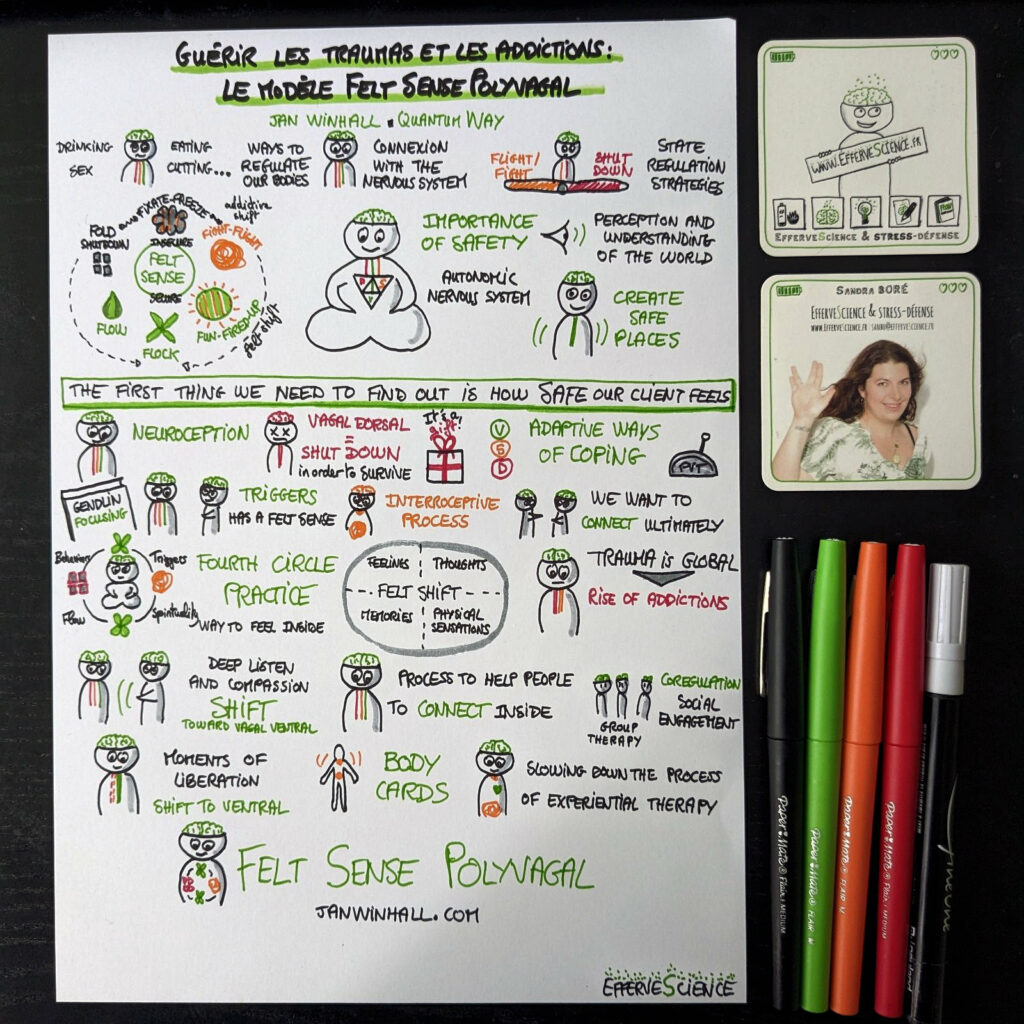 Jan Winhall’s conference at the last Quantum Way summit: my sketchnote
Jan Winhall’s conference at the last Quantum Way summit: my sketchnote
I’m really pleased than Jan agreed to introduce her model in an interview, and that she allowed me to translate her graphic models into French for the french audience (thanks again!).
But what is the Felt Sense Polyvagal Model? And what are the graphic models?
Let’s dive into the universe of Jan Winhall!
The Felt Sense Polyvagal Model for trauma and addiction
Jan Winhall is a psychotherapist, she were a social worker, and she developped the « Felt Sense Polyvagal Model » mixing Felt Sense Experience that she’s created and Stephen Porges’ PolyVagal Theory.
Jan’s approach put the emphasis on listening to patients, especially trauma survivors, with “de-pathologizing ears”, crossing Judith Herman’s and Stephen Porges’ work which describe trauma and addictive behaviors as adaptative process.
Addaptative behaviors go from sympathetic flooding to dorsal numbing, and these addictions and self-harm functions were to shift people from one autonomic state to the other, as describe by Stephen Porges.
“We’re de-pathologizing addiction and understanding it as a state regulation strategy.”
Jan Winhall
It’s a real shift of paradigm: we’re not talking about pathology anymore, we’re talking about the wisdom of the body to adapt to different situations in order to survive.
As usual the PolyVagal Theory is very guilt-freeing, exploring and describing adaptation instead of pathology.
But there may be adaptation disorders and bodies can be stuck in ruts, a trauma feedback loops where we can get stuck in addiction.
On this subject, what is an addiction?
Jan Winhall introduces a three step definition for addictions:
- They help us in the beginning
- Eventually they’ll begin to harm us in the long way
- We can’t stop doing them
It works with alcohol or drug abuse… but also with work, and workaholism is a real topic when we talk about burnout…
We can binge in work, with big projects that take all of our time, the same way we binge with alcoholism.
The Felt Sense PolyVagal Model is a way to reconnect to our bodies, who are really left behind in our cultures.
It mixes Eugene Gendlin’s “Felt Sense” and Stephen Porges’ neuroception and interoception.
Felt Sense, neuroception and interoception are ways to observe and understand how changes are made in our bodies, state changes like we see in PolyVagal Theory.
The goal is to feel safe enough to slow things down and observe what is going on in our body, with a process called Focusing : “What’s going on inside me now?”
It’s an invitation to listen to the “felt sense”, a kind of intuition, an inkling of an idea, somehow connected to neuroception : how safe do you feel? Which state are you in?
And in the end we can observe “felt shifts“, a change in state.
Felt Sense PolyVagal Model is a way to understand and observe felt sense and felt shifts… which means you have to know the states… and here come the graphic models!
PolyVagal Theory illustrated: the graphic models
Jan Winhall provided two graphic models for her Felt Sense PolyVagal Model, starting with one for the clinicians:
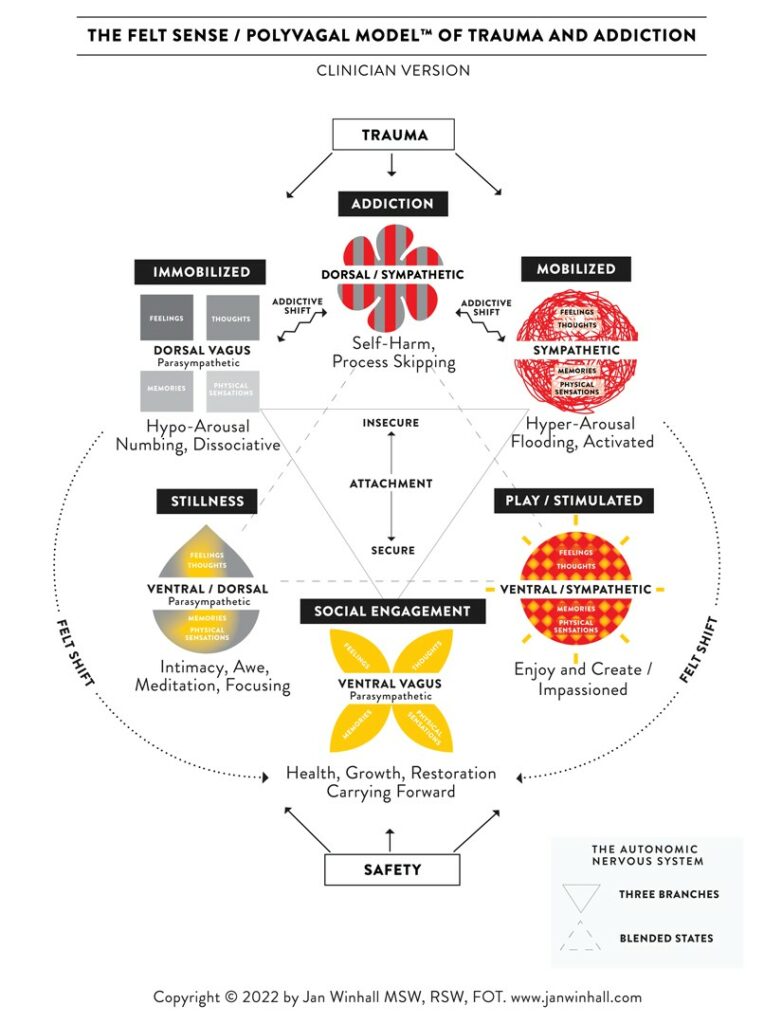
I do LOVE it, but most of the clients found it too difficult, so Jan and her clients and students came with a model for patients, the 6 Fs:
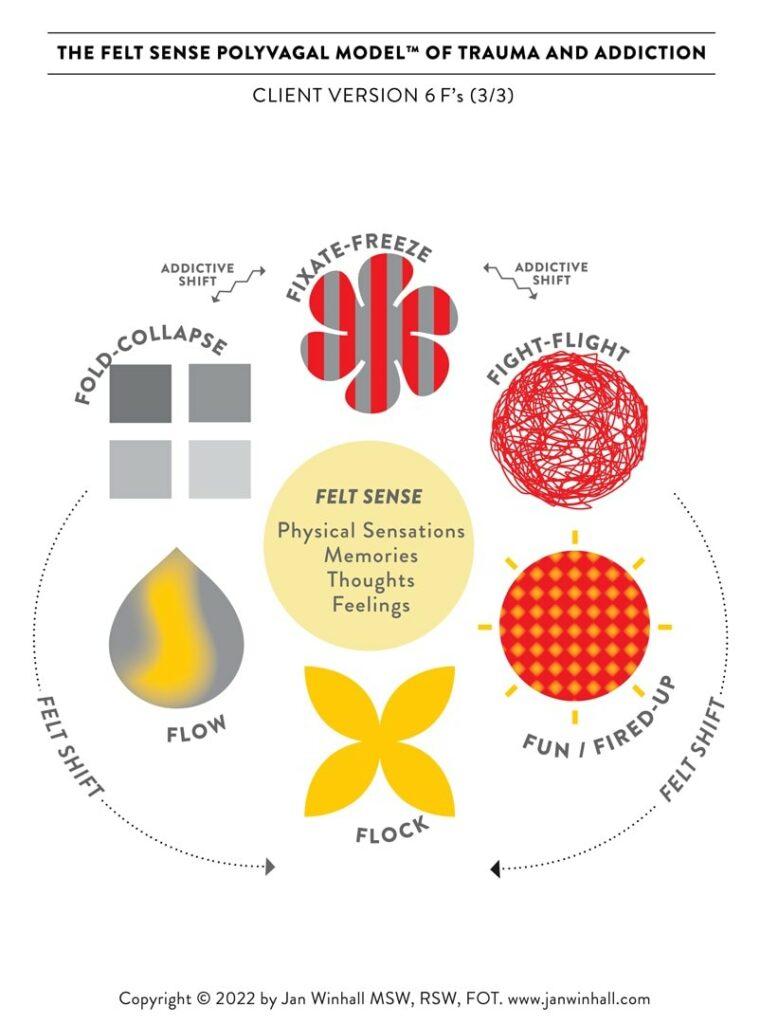 You can download high res versions on Jan’s website, with other tools
You can download high res versions on Jan’s website, with other tools
It’s an invitation to recognize and describe where we are on these graphic models, it’s simple, and it’s visual: people can print it an put it on their wall or fridge, it can be a way to communicate how we feel and what are our needs… brilliant!
And for those who are more used to “my” triforces (even if we do have the triangle in common for the states, just my ventral is on top), here’s what Jan’s model would look like in a “triforce version”:
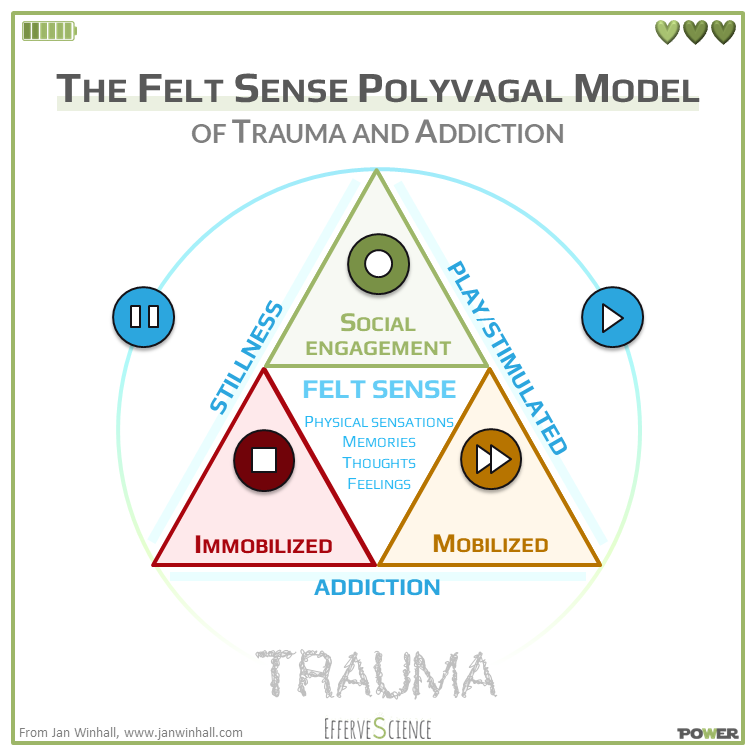 Jan’s clinician model in a triforce version
Jan’s clinician model in a triforce version
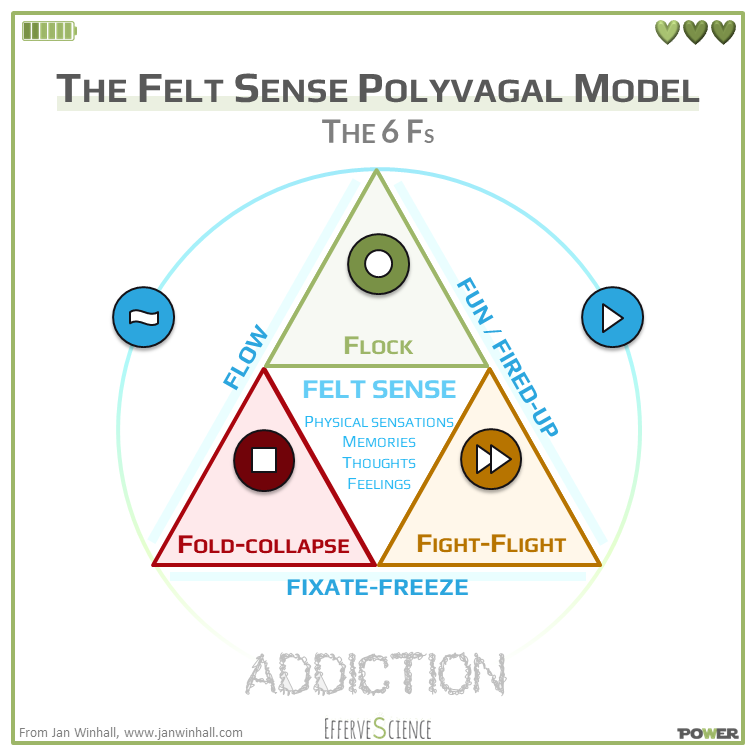 Jan’s 6Fs for clients in a triforce version
Jan’s 6Fs for clients in a triforce version
Of course I’ve translated both original graphic models and triforces in the French version of this article.
AND if you want to use these models in your practice you can download them in high res on Jan’s website.
The rules of the game is to identify where you are in the model, and find what do you need to go in a more grounded and ventral state.
And there are a LOT of pratices from breathing to body connection to go to a more grounded state.
A trilogy of states… and even more
In Jan’s model there’re three blended states : fun and fired up is for playing, a mix of ventral and sympathetic (Porges talks a lot about play is his books), and two others that are really new and that I’ld like to talk about.
First of all Jan now describe the « freeze state » as a blend of dorsal immobilisation AND sympathetic mobilization, explaining that this blended state plays an important role in addiction : it’s really new, and I’ve first thought that “freeze” state was only dorsal in the beginning… so did Jan, and I feel reassured I wasn’t the only one mistaking 🙂
Actually we both discover that “freeze state” was a mixed state thanks to the work of the PolyVagal Institute :
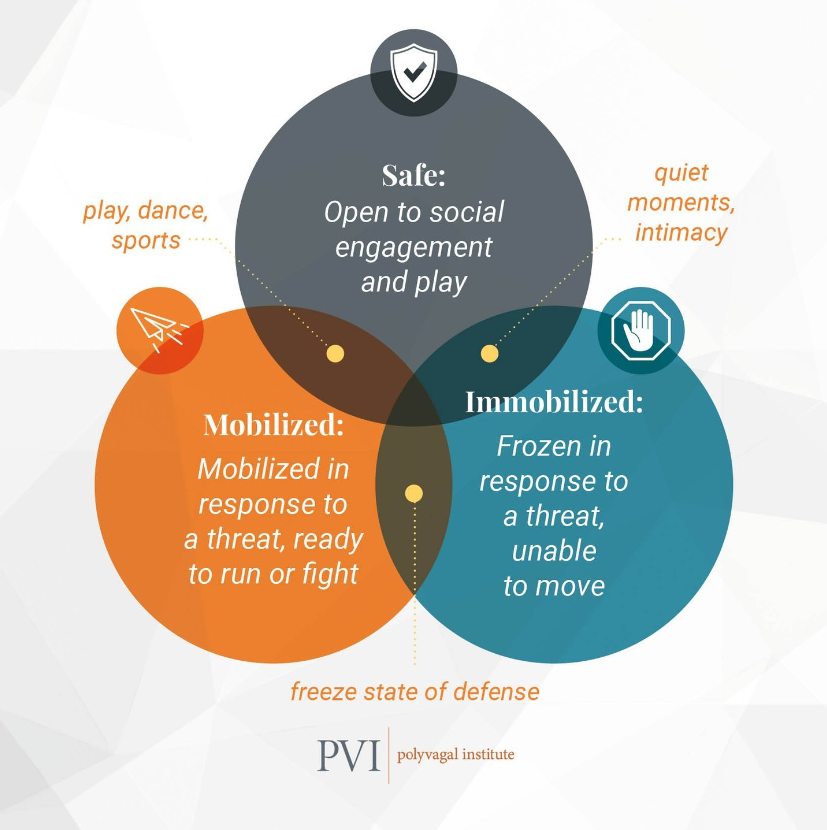 PolyVagal Institute’s blended states
PolyVagal Institute’s blended states
Or for an upddated representation crossed with Jan’s work :
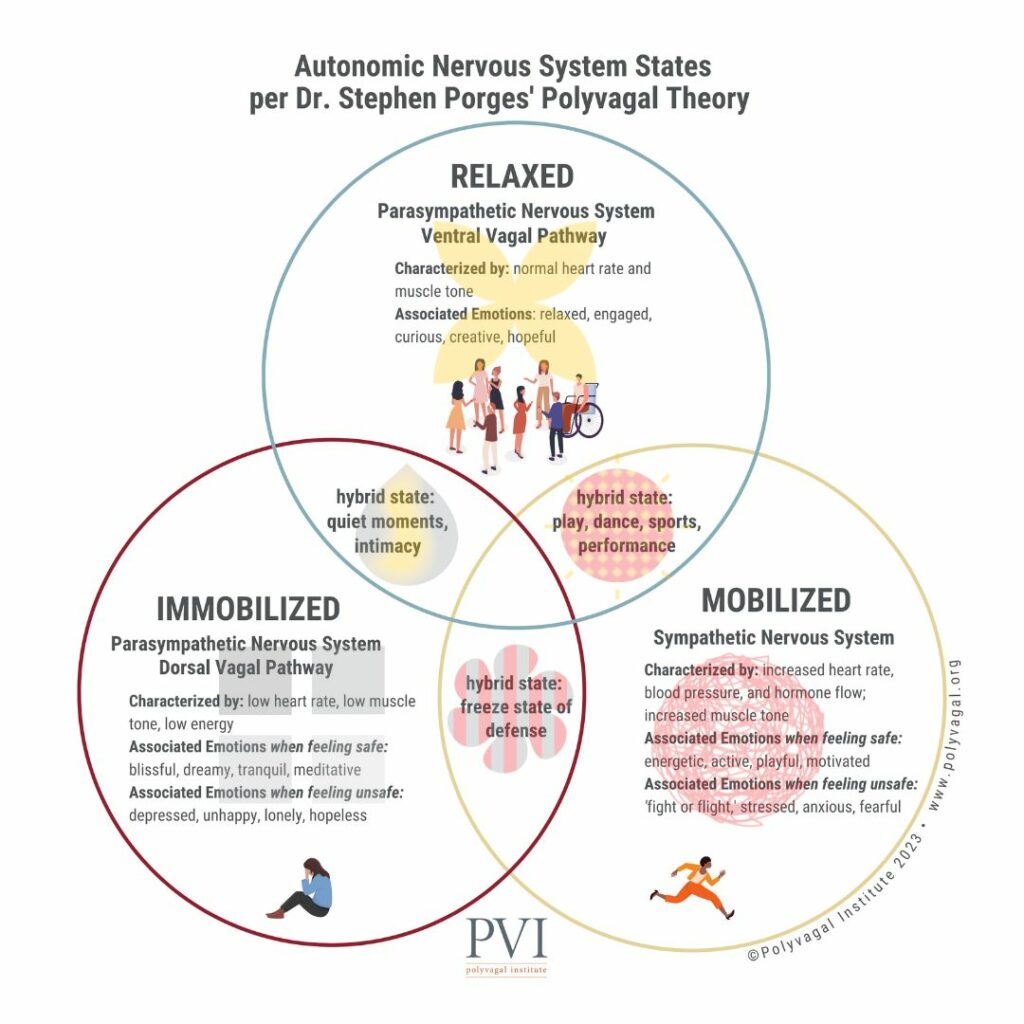
When we observe the body, the freeze state is constricted, it’s a blend of dorsal immobilisation and a sympathetic constriction! (taddaaa!)
And so I was wrong, or at least not entirely accurate in my book (well I did not have a PolyVagal Institute to read what I wrote, and it was in French so…)
And in a triforce version it looks like this:
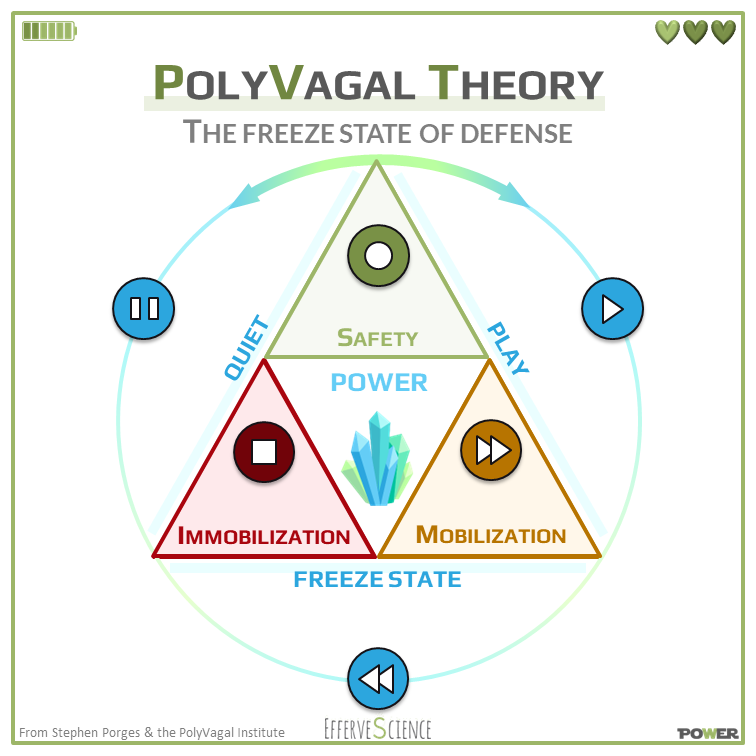
In addiction we go back and forth between surging up into sympathetic and then shutting down into dorsal, in a trauma feedback loop.
Addicted people are stuck in this trauma feedback loop, using behaviors or substances to go from one state to another.
Once again: it’s an adaptative behovior, not a desease.
Ultimately people need to stop their addictive behaviors to go back to ventral where everything flows and where we don’t need addiction to go from on state to another, to adapt to relationships and environment.
“We do not need addiction in ventral.”
Jan Winhall
There is also a “flow state” in Jan’s 6Fs graphic model, and it is a blend of ventral and dorsal response.
Actually here we have to think of the flow state as a state of stillness, safety and confidence (Porges talks about “stillness”).
It is when we feel safe enough to be still, like in cuddling, lovemaking or breastfeeding.
It surprised me because I thought that we needed a sympathetic impulse to go in a “flow state”, this state of mastery where everything seems easy and effortless but it’s not the same use of the term “flow”. Mihály Csíkszentmihályi’s work about flow, as described by artists or sportsmen performing is more active and do need some sympathetic, and a lot of ventral 🙂
Applied PVT: Jan’s tools
There are a lot of ressources on Jan Winhall’s website : her paper co-authored with Stephen Porges, about how the Felt Sense PolyVagal Model revolutionized addiction treatment, the graphic models we talked about (and that I’ve translated into French) but also Body Cards to represent what we feel and the Four Circles pratices.
All of them can be dowloaded for free on Jan’s website, but we need to teach ourselves how to introduce these tools into our pratices, and it starts by using them for ourselves.
All of these tools are descibed, with exemples, on Stephen Porges’ and Jan Winhall’s paper, but you can also sign up to one of Jan’s training sessions and/or online courses to go further into her approach, and introduce these tools for your clients, if you’re a clinician, coach or therapist 🙂
You can also request access to Jan’s “Felt Sense Polyvagal Approach to Trauma” group in the PolyVagal Institute community for ressources sharing and monthly inspiration!
And we French people do hope that Jan’s book will be available in French one day, or that one of her online courses will be translated by Quantum Way… (you can already sign up for Jan’s masterclass in septembre)
And of course you’re invited to print one or both of the graphic models to learn to recognize and play with your states!
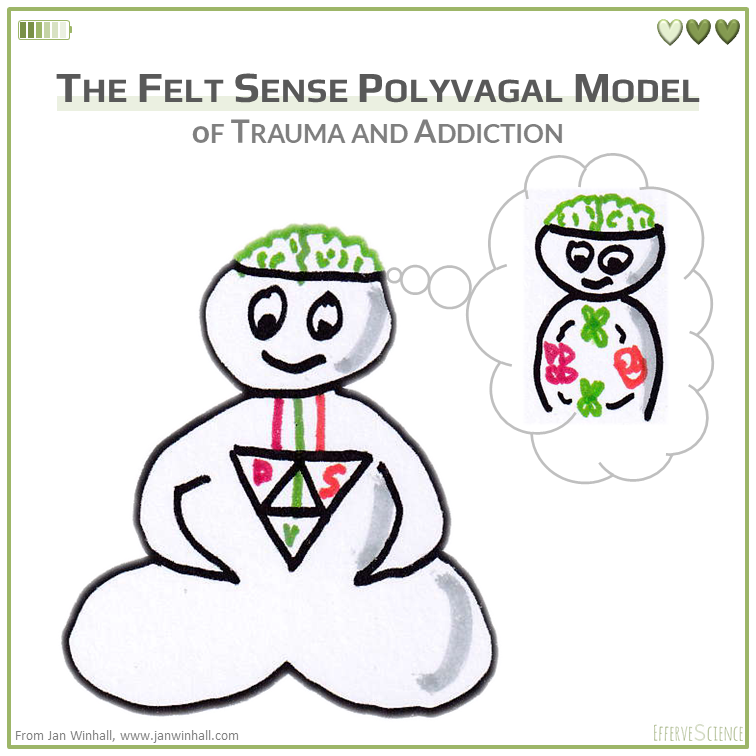




Trackbacks/Pingbacks